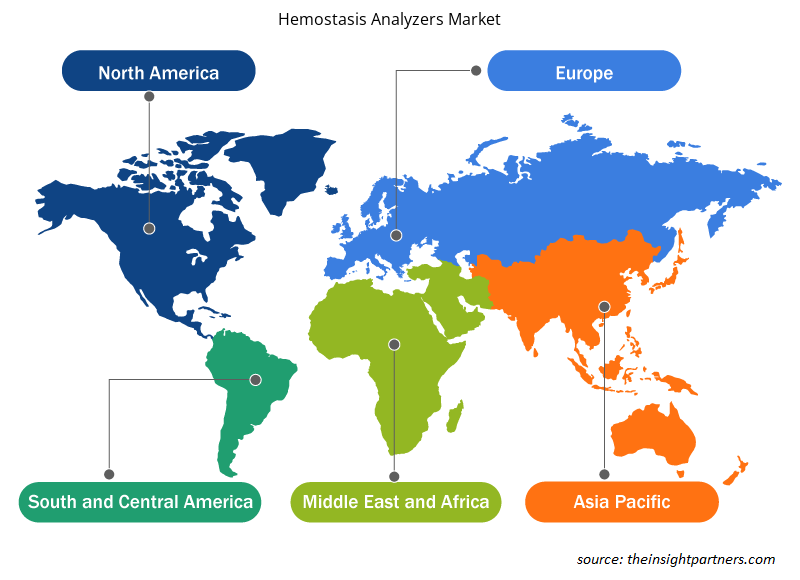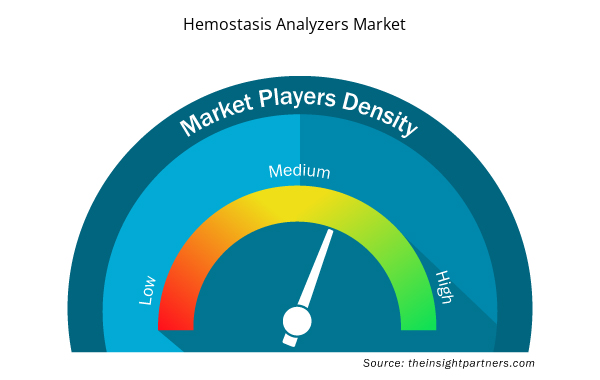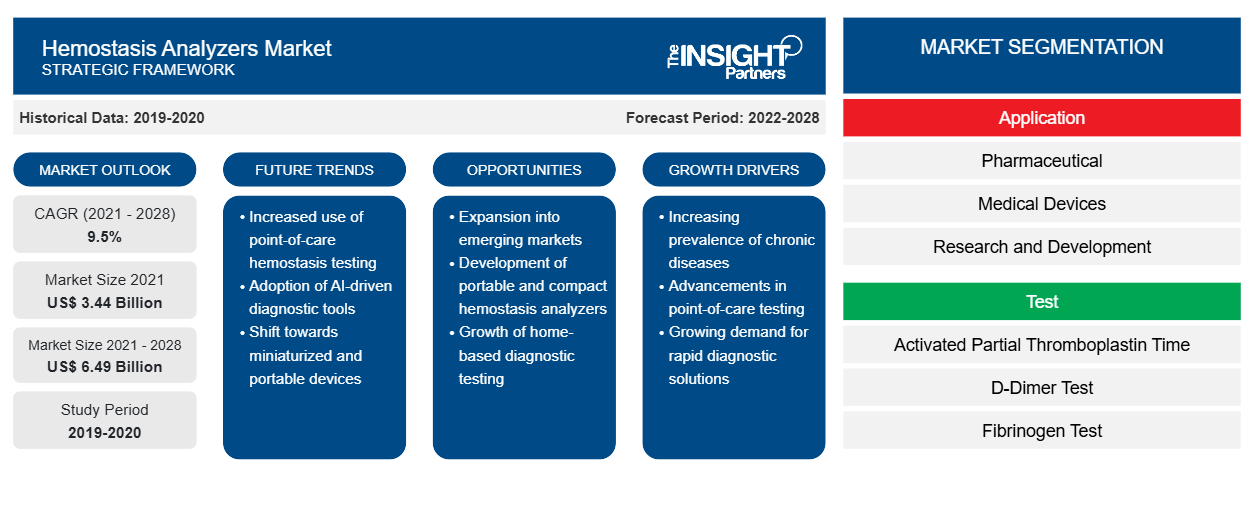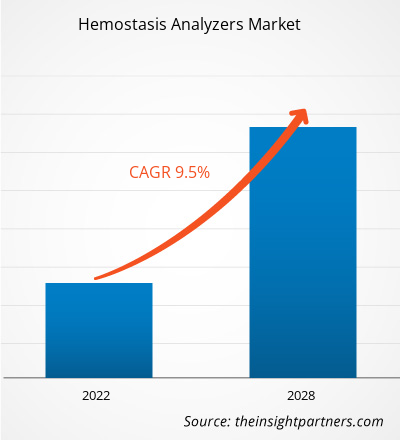Der Markt für Hämostaseanalysatoren soll von 3.440,66 Millionen US-Dollar im Jahr 2021 auf 6.490,24 Millionen US-Dollar im Jahr 2028 anwachsen; für den Zeitraum von 2021 bis 2028 wird eine durchschnittliche jährliche Wachstumsrate (CAGR) von 9,5 % erwartet.
Hämostaseanalysatoren ermöglichen eine schnelle und einfache Messung des Blutplättchenspiegels. Ein Gerinnungstest kann helfen, Blutgerinnsel zu erkennen und zu verhindern, die einen Herzinfarkt verursachen könnten. Ein Gerinnungsanalysator kann die Geschwindigkeit des Gerinnungswegs und die Mengen an Thrombolin und Thromboplastin in weniger als ein paar Minuten messen. Herz-Kreislauf-Erkrankungen (CVDs) bleiben wahrscheinlich die bedeutendste Ursache für Morbidität und Mortalität weltweit. Die CVDs sind Erkrankungen des Herzens und der Blutgefäße und umfassen zerebrovaskuläre Erkrankungen, koronare Herzkrankheiten, rheumatische Herzkrankheiten und andere Erkrankungen. Einige lebensstilbedingte Probleme, die zu Herz-Kreislauf-Erkrankungen und -Beschwerden führen, sind Tabakkonsum, ungesunde Ernährung und körperliche Inaktivität. Sie erhöhen das Risiko von Herzinfarkten und Schlaganfällen. Weitere Risikofaktoren für Herz-Kreislauf-Erkrankungen sind Bluthochdruck, Diabetes und erhöhte Cholesterinwerte. Laut der Weltgesundheitsorganisation (WHO) sind Herz-Kreislauf-Erkrankungen weltweit die häufigste Todesursache.
Passen Sie diesen Bericht Ihren Anforderungen an
Sie erhalten kostenlos individuelle Anpassungen an jedem Bericht, einschließlich Teilen dieses Berichts oder einer Analyse auf Länderebene, eines Excel-Datenpakets sowie tolle Angebote und Rabatte für Start-ups und Universitäten.
- Holen Sie sich die wichtigsten Markttrends aus diesem Bericht.Dieses KOSTENLOSE Beispiel umfasst eine Datenanalyse von Markttrends bis hin zu Schätzungen und Prognosen.
Markteinblicke:
Anstieg der geriatrischen Bevölkerung treibt den Markt für Hämostaseanalysatoren an
Ältere Menschen sind aufgrund schwacher Immunität und anderer gesundheitlicher Probleme anfällig für Herzkrankheiten. Allgemeine Alterungsfaktoren führen zu einer Versteifung des Herzens und der Blutgefäße, was zu Herzerkrankungen führt. Mit zunehmendem Alter steigt auch der systolische Blutdruck, was zu Herz-Kreislauf-Erkrankungen (CVDs) führt. Daher ist Bluthochdruck bei Menschen ab 75 Jahren ein häufiger Risikofaktor für Herzkrankheiten. Koronare Herzkrankheit und Herzinsuffizienz sind die anderen. Obwohl die Häufigkeit von Herzrhythmusstörungen Menschen aller Altersgruppen betrifft, steigt sie bei der geriatrischen Bevölkerung erheblich an.
Laut der Studie „Global Ageing 2019“ betrug die Weltbevölkerung im Jahr 2019 703 Millionen Menschen im Alter von 65 Jahren und älter. Bis 2050 wird sich diese demografische Gruppe voraussichtlich auf 1,5 Milliarden Menschen verdoppeln. Die Häufigkeit, mit der eine Person über 65 Jahre alt ist, wird voraussichtlich von 1 von 11 Einwohnern im Jahr 2019 auf 1 von 6 Einwohnern bis 2025 steigen. Diese demografische Gruppe ist anfälliger für Herz-Kreislauf-Erkrankungen wie Herzrhythmusstörungen. Und laut der Weltgesundheitsorganisation (WHO) wird der Anteil der Menschen im Alter von 60 Jahren und älter von 12 % im Jahr 2015 auf 22 % bis 2050 ansteigen. Laut dem Bericht „Older Americans 2016: Key Indicators of Well-Being“ des Federal Interagency Forum on Aging-Related Statistics hatten 35,8 % der Personen im Alter von 85 Jahren und älter eine leichte oder schwere kognitive Störung. Darüber hinaus waren laut dem Bericht der Vereinten Nationen zur Alterung der Weltbevölkerung 2017 weltweit 962 Millionen Menschen 60 Jahre oder älter, und diese Zahl wird bis 2050 voraussichtlich auf fast 2,1 Milliarden ansteigen.
Die ältere Bevölkerung ist anfälliger für atypische Krankheitsbilder, Begleiterkrankungen und ungünstige Folgen. Der Hauptgrund für die Krankheiten sind die strukturellen und funktionellen Veränderungen des Herz-Kreislauf-Systems, die mit dem Altern einhergehen. Der Anstieg der geriatrischen Bevölkerung weltweit führt zu einem Anstieg der Herz-Kreislauf-Erkrankungen, was wiederum die Nachfrage nach Hämostase-Analysegeräten ankurbelt.
Produkttypbasierte Einblicke
Basierend auf dem Produkttyp ist der Markt für Hämostaseanalysatoren weiter in Laboranalysatoren und Point-of-Care-Testsysteme unterteilt . Im Jahr 2021 hält das Segment der Laboranalysatoren den größten Marktanteil, und das Segment der Point-of-Care-Testsysteme dürfte im Zeitraum 2021–2028 die höchste durchschnittliche jährliche Wachstumsrate verzeichnen.
Marktanteil von Hämostaseanalysatoren nach Produkttyp – 2021 und 2028
Testbasierte Erkenntnisse
Basierend auf Tests ist der Markt in aktivierte partielle Thromboplastinzeit, D-Dimer-Test, Fibrinogentest, Prothrombinzeittest und andere unterteilt. Im Jahr 2021 hatte das Segment der aktivierten partiellen Thromboplastinzeit den größten Marktanteil. Das Segment der Prothrombinzeittests wird voraussichtlich zwischen 2021 und 2028 die höchste durchschnittliche jährliche Wachstumsrate auf dem Markt verzeichnen.
Endbenutzerbasierte Erkenntnisse
Based on end users, the market is segmented into hospitals/clinics, independent diagnostic laboratories, home care settings, and others. In 2021, the hospitals/clinics segment accounted for the largest share of the market. The independent diagnostic laboratories segment is expected to register the highest CAGR in the market during 2021–2028.
Companies operating in the hemostasis analyzers market emphasize adopting the strategy of product innovations to meet the evolving customer demands worldwide, which also permits them to maintain their brand name in the global market.
Hemostasis Analyzers Market – Segmentation
The Hemostasis Analyzers market is segmented based on product type, test, and end-user. Based on product type, the hemostasis analyzers market is segmented into laboratory analyzers and point-of-care testing systems. Based on test, the market is further segmented into activated partial thromboplastin time, D-Dimer test, fibrinogen test, prothrombin time test, and others. Based on end-user, the market is segmented into hospitals/clinics, independent diagnostic laboratories, home care settings, and others. In terms of geography, the hemostasis analyzers market is segmented into North America (the US, Canada, and Mexico), Europe (France, Germany, Italy, the UK, Spain, and the Rest of Europe), Asia Pacific (Australia, China, India, Japan, South Korea, and the Rest of APAC), the Middle East & Africa (Saudi Arabia, South Africa, the UAE, and the Rest of MEA), and South and Central America (Brazil, Argentina, and the Rest of SCAM)
Hemostasis Analyzers Market Regional Insights
The regional trends and factors influencing the Hemostasis Analyzers Market throughout the forecast period have been thoroughly explained by the analysts at Insight Partners. This section also discusses Hemostasis Analyzers Market segments and geography across North America, Europe, Asia Pacific, Middle East and Africa, and South and Central America.

- Get the Regional Specific Data for Hemostasis Analyzers Market
Hemostasis Analyzers Market Report Scope
| Report Attribute | Details |
|---|---|
| Market size in 2021 | US$ 3.44 Billion |
| Market Size by 2028 | US$ 6.49 Billion |
| Global CAGR (2021 - 2028) | 9.5% |
| Historical Data | 2019-2020 |
| Forecast period | 2022-2028 |
| Segments Covered | By Application
|
| Regions and Countries Covered | North America
|
| Market leaders and key company profiles |
|
Marktteilnehmerdichte: Der Einfluss auf die Geschäftsdynamik
Der Markt für Hämostaseanalysatoren wächst rasant, angetrieben durch die steigende Nachfrage der Endnutzer aufgrund von Faktoren wie sich entwickelnden Verbraucherpräferenzen, technologischen Fortschritten und einem größeren Bewusstsein für die Vorteile des Produkts. Mit steigender Nachfrage erweitern Unternehmen ihr Angebot, entwickeln Innovationen, um die Bedürfnisse der Verbraucher zu erfüllen, und nutzen neue Trends, was das Marktwachstum weiter ankurbelt.
Die Marktteilnehmerdichte bezieht sich auf die Verteilung der Firmen oder Unternehmen, die in einem bestimmten Markt oder einer bestimmten Branche tätig sind. Sie gibt an, wie viele Wettbewerber (Marktteilnehmer) in einem bestimmten Marktraum im Verhältnis zu seiner Größe oder seinem gesamten Marktwert präsent sind.
Die wichtigsten auf dem Markt für Hämostaseanalysatoren tätigen Unternehmen sind:
- Siemens AG
- Instrumentierungslabor
- Abbott
- Sysmex Corporation
- Nihon Kohden Corporation
Haftungsausschluss : Die oben aufgeführten Unternehmen sind nicht in einer bestimmten Reihenfolge aufgeführt.

- Überblick über die wichtigsten Akteure auf dem Markt für Hämostaseanalysatoren
Firmenprofile
- Siemens AG
- Instrumentierungslabor
- Abbott
- Sysmex Corporation
- Nihon Kohden Corporation
- Thermo Fisher Scientific Inc.
- Roche Diagnostics
- Diagnostica Stago
- Helena Laboratories
- Internationale Technidyne Corporation.
- Historische Analyse (2 Jahre), Basisjahr, Prognose (7 Jahre) mit CAGR
- PEST- und SWOT-Analyse
- Marktgröße Wert/Volumen – Global, Regional, Land
- Branche und Wettbewerbsumfeld
- Excel-Datensatz


- Artificial Intelligence in Healthcare Diagnosis Market
- Flexible Garden Hoses Market
- Predictive Maintenance Market
- Arterial Blood Gas Kits Market
- Electronic Signature Software Market
- Glycomics Market
- Rugged Servers Market
- Public Key Infrastructure Market
- Virtual Pipeline Systems Market
- Molecular Diagnostics Market

Report Coverage
Revenue forecast, Company Analysis, Industry landscape, Growth factors, and Trends

Segment Covered
This text is related
to segments covered.

Regional Scope
North America, Europe, Asia Pacific, Middle East & Africa, South & Central America

Country Scope
This text is related
to country scope.
Häufig gestellte Fragen
The Asia Pacific is expected to be the fastest-growing region and is likely to expand at a high growth rate due to the rising development in the pharmaceutical sector. Also, the rise in the incidence of cardiovascular diseases is likely to provide more significant growth opportunities to the market players in the coming years is likely to boost the growth of the market in the Asia Pacific region.
The global hemostasis analyzers market based on product is segmented into product type [laboratory analyzer (automated systems, semi-automated systems, and manual systems) and point-of-care testing systems. In 2021, the laboratory analyzer segment held the largest share of the market by product and point-of-care testing systems is expected to witness the fastest CAGR during 2021 to 2028.
The global hemostasis analyzers market is segmented into North America, Europe, Asia Pacific, Middle East & Africa, and South & Central America. In the North America region, the market for hemostasis analyzers market is primarily held by the US among the other countries. The growth of the hemostasis analyzers market in the United States is expected to grow owing to increasing organic developments by the market players in the market, rising awareness among consumers for treatment, and an increase in the prevalence of chronic illnesses like blood disorders and cardiovascular diseases.
The hemostasis analyzers market majorly consists of the players such as Siemens AG, Instrumentation Laboratory, Abbott, Sysmex Corporation, Nihon Kohden Corporation, Thermo Fisher Scientific Inc., Roche Diagnostics, Diagnostica Stago, Helena Laboratories, International Technidyne Corporation are amongst others.
Hemostasis analyzers are medical devices that are used to measure the clotting time of hemostasis to detect clotting deficiencies and facilitate the treatment of patients with an excess bleeding condition by medical practitioners.
The factors driving and restraining the hemostasis analyzers market in the coming years include the high prevalence of cardiovascular diseases and the rise in the geriatric population. However, the high cost of a fully automated hemostasis analyzer is likely to hamper the market's growth.
Trends and growth analysis reports related to Life Sciences : READ MORE..
The List of Companies - Hemostasis Analyzers Market
- Siemens AG
- Instrumentation Laboratory
- Abbott
- Sysmex Corporation
- Nihon Kohden Corporation
- Thermo Fisher Scientific Inc.
- Roche Diagnostics
- Diagnostica Stago
- Helena Laboratories
- International Technidyne Corporation
The Insight Partners performs research in 4 major stages: Data Collection & Secondary Research, Primary Research, Data Analysis and Data Triangulation & Final Review.
- Data Collection and Secondary Research:
As a market research and consulting firm operating from a decade, we have published and advised several client across the globe. First step for any study will start with an assessment of currently available data and insights from existing reports. Further, historical and current market information is collected from Investor Presentations, Annual Reports, SEC Filings, etc., and other information related to company’s performance and market positioning are gathered from Paid Databases (Factiva, Hoovers, and Reuters) and various other publications available in public domain.
Several associations trade associates, technical forums, institutes, societies and organization are accessed to gain technical as well as market related insights through their publications such as research papers, blogs and press releases related to the studies are referred to get cues about the market. Further, white papers, journals, magazines, and other news articles published in last 3 years are scrutinized and analyzed to understand the current market trends.
- Primary Research:
The primarily interview analysis comprise of data obtained from industry participants interview and answers to survey questions gathered by in-house primary team.
For primary research, interviews are conducted with industry experts/CEOs/Marketing Managers/VPs/Subject Matter Experts from both demand and supply side to get a 360-degree view of the market. The primary team conducts several interviews based on the complexity of the markets to understand the various market trends and dynamics which makes research more credible and precise.
A typical research interview fulfils the following functions:
- Provides first-hand information on the market size, market trends, growth trends, competitive landscape, and outlook
- Validates and strengthens in-house secondary research findings
- Develops the analysis team’s expertise and market understanding
Primary research involves email interactions and telephone interviews for each market, category, segment, and sub-segment across geographies. The participants who typically take part in such a process include, but are not limited to:
- Industry participants: VPs, business development managers, market intelligence managers and national sales managers
- Outside experts: Valuation experts, research analysts and key opinion leaders specializing in the electronics and semiconductor industry.
Below is the breakup of our primary respondents by company, designation, and region:

Once we receive the confirmation from primary research sources or primary respondents, we finalize the base year market estimation and forecast the data as per the macroeconomic and microeconomic factors assessed during data collection.
- Data Analysis:
Once data is validated through both secondary as well as primary respondents, we finalize the market estimations by hypothesis formulation and factor analysis at regional and country level.
- Macro-Economic Factor Analysis:
We analyse macroeconomic indicators such the gross domestic product (GDP), increase in the demand for goods and services across industries, technological advancement, regional economic growth, governmental policies, the influence of COVID-19, PEST analysis, and other aspects. This analysis aids in setting benchmarks for various nations/regions and approximating market splits. Additionally, the general trend of the aforementioned components aid in determining the market's development possibilities.
- Country Level Data:
Various factors that are especially aligned to the country are taken into account to determine the market size for a certain area and country, including the presence of vendors, such as headquarters and offices, the country's GDP, demand patterns, and industry growth. To comprehend the market dynamics for the nation, a number of growth variables, inhibitors, application areas, and current market trends are researched. The aforementioned elements aid in determining the country's overall market's growth potential.
- Company Profile:
The “Table of Contents” is formulated by listing and analyzing more than 25 - 30 companies operating in the market ecosystem across geographies. However, we profile only 10 companies as a standard practice in our syndicate reports. These 10 companies comprise leading, emerging, and regional players. Nonetheless, our analysis is not restricted to the 10 listed companies, we also analyze other companies present in the market to develop a holistic view and understand the prevailing trends. The “Company Profiles” section in the report covers key facts, business description, products & services, financial information, SWOT analysis, and key developments. The financial information presented is extracted from the annual reports and official documents of the publicly listed companies. Upon collecting the information for the sections of respective companies, we verify them via various primary sources and then compile the data in respective company profiles. The company level information helps us in deriving the base number as well as in forecasting the market size.
- Developing Base Number:
Aggregation of sales statistics (2020-2022) and macro-economic factor, and other secondary and primary research insights are utilized to arrive at base number and related market shares for 2022. The data gaps are identified in this step and relevant market data is analyzed, collected from paid primary interviews or databases. On finalizing the base year market size, forecasts are developed on the basis of macro-economic, industry and market growth factors and company level analysis.
- Data Triangulation and Final Review:
The market findings and base year market size calculations are validated from supply as well as demand side. Demand side validations are based on macro-economic factor analysis and benchmarks for respective regions and countries. In case of supply side validations, revenues of major companies are estimated (in case not available) based on industry benchmark, approximate number of employees, product portfolio, and primary interviews revenues are gathered. Further revenue from target product/service segment is assessed to avoid overshooting of market statistics. In case of heavy deviations between supply and demand side values, all thes steps are repeated to achieve synchronization.
We follow an iterative model, wherein we share our research findings with Subject Matter Experts (SME’s) and Key Opinion Leaders (KOLs) until consensus view of the market is not formulated – this model negates any drastic deviation in the opinions of experts. Only validated and universally acceptable research findings are quoted in our reports.
We have important check points that we use to validate our research findings – which we call – data triangulation, where we validate the information, we generate from secondary sources with primary interviews and then we re-validate with our internal data bases and Subject matter experts. This comprehensive model enables us to deliver high quality, reliable data in shortest possible time.


 Holen Sie sich ein kostenloses Muster für diesen Bericht
Holen Sie sich ein kostenloses Muster für diesen Bericht